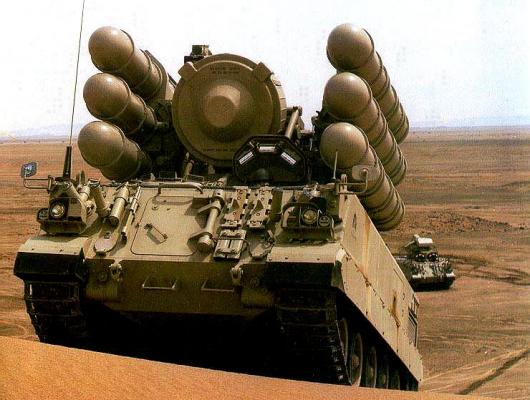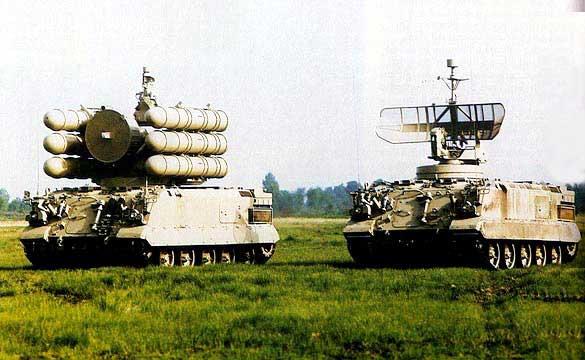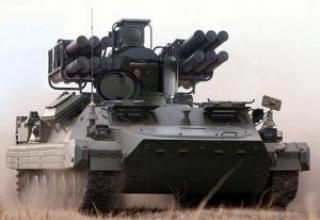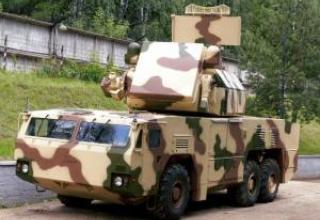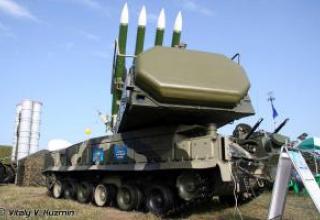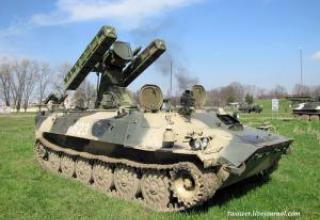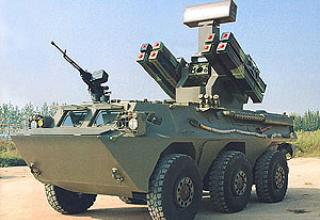Short range anti-aircraft missile system "Shanine" - all-weather mobile military air defense system, designed to combat targets flying at low altitudes. The complex was developed by Thomson-CSF under a contract with Saudi Arabia on the basis of a widespread complex "Crotale".
It is in service with the Saudi Army.
In 1984 Saudi Arabia has concluded the contract with firm "Thomson-CSF" about creation of the modernized version of the complex which has received the name "Shahine-2". The cost of the contract made 4 million US dollars. In 1991-1993 several batteries of "Shahine" complex were modernized to the level of "Shahine-2".
Composition:
Shanine's" SAMs are part of it:
- Air target detection radar (detection unit);
- launchers (PU) with radars for target tracking and SAM guidance (fire unit) installed on them;
Airborne target detection radars and launchers with target tracking and SAM guidance radars are mounted on the tracked chassis of the AMX-30 tank.
The detection radar is a pulsed Doppler E/F-band radar with a detection range of 18500m (detection height - 6000 m), equipped with a system of selection of moving targets. It allows to accompany up to 40 targets and automatically identify 12 most dangerous ones. The additional television system is placed on the turret and provides optical reconnaissance of terrain and targets while the complex is moving. One detection radar controls three or four launchers. Compared to the basic version of the Crotale system, it has higher resolution and range. The antenna's azimuth pattern has been reduced from 3.5° to 1.4°. The radar is equipped with a digital communication system, which allows receiving data from the Litton TSQ-73 control center, and equipment for automatic positioning of the launchers and input of parallax, which allows to open fire as soon as the PU stops moving.
The launcher is equipped with six SSDs instead of four. The R460 missile of the "Shahine" complex is an upgraded version of the R440 missile of the "Crotale" complex, due to the use of a new more powerful engine in the missile with a 4.5s operating time of the complex extended . Shrapnel-type directional combat unit, has contact and non-contact passive infrared fuses. The radius of destruction of the combat unit is 8m, the velocity of splinters is 2.3m/s.
The launcher is equipped with a monopulse Doppler tracking and guidance radar for J-band missiles (range - 17,000 m). The radar provides simultaneous escort to the target and one or two guided missiles. The radar has a digital receiver and a circular polarization antenna.
The probability of hitting the target with an effective scattering surface of 1m2 and a speed of 250m/sec is 0.9, and when using two missiles - 0.99.
The IVPDL (Inter-Venicle Position and Data Link) communication system allows to carry the detection node and the fire node to a range up to 4000 m. It is possible to receive information from a neighboring detection node at ranges up to 7000 m. Other communication systems allow you to integrate the detection node with the superior command post and receive from him the required information about the air situation.
Modernized complex "Shahine-2" can be mounted on AMX-30 chassis or towed trailer. The latest version was named ATTS - Air Transportable Towed System. Modular design of the detection system and fire alarm system allows to place them on any platform. In the "Shahine-2" complex the range of the observation radar was increased to 19 500 m. In addition, the missile uses an electromagnetic contact fuse instead of an IR detonator.
Characteristics:
| Range of fire, m | |
| maximum | 11800 |
| minimum | 500 |
| Intercept height, m | |
| maximum | 3000 |
| minimum | 50 |
| Maximum missile flight speed | 2.8М |
| The reaction time, s | 6 |
| Maximum target speed, m/s | 410 |
| Start weight, kg | 105 |
| Length of ZUR, mm | 3120 |
| ZUR body diameter, mm | 156 |
| Wingspan, mm | 590 |
| Maximum flight speed of ZUR, m/s | 850 |
| Weight BC, kg | 15 |
Testing:
In the Anglo-Argentine conflict, five Argentine aircraft were shot down using this complex. Attacks by British frigates like "Broadsworth" links of four attack aircraft like "Skyhawk" each link lost half of the planes, the rest, trying to hit the ships with antimissile maneuver, bombed inaccurately. As a result, even before the end of the conflict, Argentine pilots began to avoid encountering ships of this type, choosing other targets for attack.
After the end of the conflict in the South Atlantic, the British Navy specifically practiced intercepting missiles "Exocet" using Sea wolf SAMs. Frigate "Jupiter" launched an anti-ship missile (SLCM) from the over-the-horizon range on a surface target, simulating an aircraft carrier. The object of the strike covered the frigate URC type "Broadsworth", which was not notified of the launch of the missile and followed a course perpendicular to the expected trajectory of the missile. At a range of about 30 km the ship's radar 967 found an approaching target and gave it to the car escort of the radar 910. The Sea wolf missile, which was launched from the aft PU, intercepted PCR at a range of about 3 km from the ship.
Sources:
- Викторов В. "ЗРК сухопутных войск капиталистических стран", Зарубежное военное обозрение,N5 1985.
